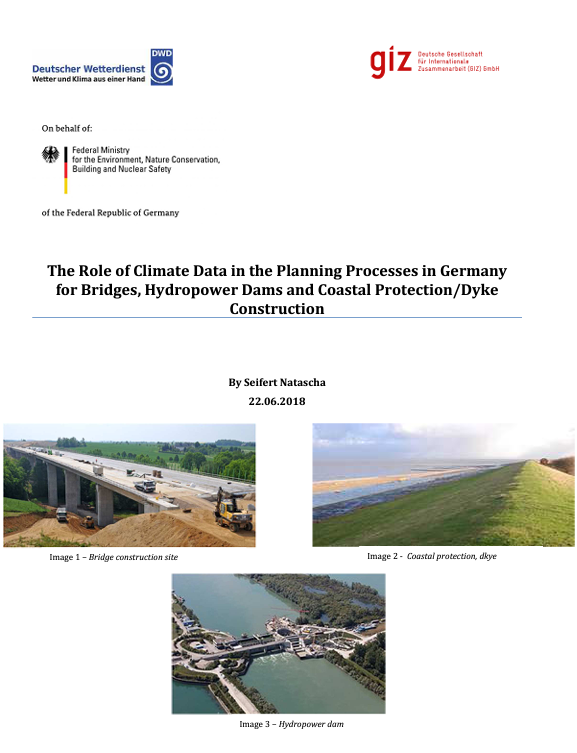Article /
The Role of Climate Data in the Planning Processes in Germany for Bridges, Hydropower Dams and Coastal Protection/Dyke Construction

Summary
This resource was submitted by the Climate Risk Institute for use by the CanAdapt Climate Change Adaptation Community of Practice.
This article is an abridged version of the original text, which can be downloaded from the right-hand column. Please access the original text for more detail, research purposes, full references, or to quote text.
The incorporation of climate change into infrastructure planning is one of the greatest challenges of the 21st century. For many years infrastructure has been planned without incorporating long term planning strategies adapting to climate change. Although planners have considered it, not enough alternatives where incorporated, as they assumed the climate will stay constant. As a result, not only individuals are threatened, but the economy as a whole. Many infrastructure projects in Germany are already facing the threats of climate change (Adaptation Action Plan of the German Strategy for Adaptation to Climate Change, 2011). The most evident example can be seen in coastal protection and flooding adaptation measures. Due to insufficient planning and usage of climate services and predictions, adaptation measures failed under the threat of climatic events. Such an example can be seen in the floods in Dresden, Hamburg and other cities in many conceding years, where the waters still managed to flood the city, although adaptation measures had been put in place (Floodlist, 2018). In addition to this, many bridges, hydropower dams and other infrastructures have seen failures due to underestimated planned measures of the time. As one can see, climate change therefore leads to a greater vulnerability of such infrastructures and imposes a threat to the future generations and livelihoods of individuals. Therefore the question arises of, how the planning of certain infrastructure projects work and where the entry points for climate data under current methods are? When this is assessed, the current planning processes have to adapt these entry points to incorporate climate services and projections in a sense of making the infrastructure more resilient towards climate change.
The act of planning, organizing and constructing any infrastructure project however is a very complex and comprehensive topic. The process runs through a lot of steps and incorporates a vast sum of actors involved. Well planned and long lasting infrastructure is the backbone of a healthy economy. ”Infrastructure enables trade, power businesses, connects workers to their jobs, creates opportunities for struggling communities and protects the nation from an increasingly unpredictable natural environment” (Puentes, 2015). In Germany the political system is polycentric and decentralized, meaning it is the job of the federal states to set priorities and make political decisions, based on the scientific information and financial support provided by the national government (Lorenz et al, 2017). Therefore new projects have to be communicated clearly and agreed with the government, states and individuals before implementation. There are many steps in this process and therefore these have to be monitored and organized accordingly. Setting this into the climatic agenda, the question arises, where and when climate data plays a role and how strong it influences the planning processes. As infrastructure projects aim to have a long life span, the incorporation of climate change needs to be evident, as these projects will be exposed to the effects of climate change.
For years scientist and meteorologists have been collecting and analyzing weather patterns and trends and generating climate data, however up until recent years, climate data has never been seen to have a big influence in the planning process for future events. Nonetheless, with our changing environment steering to more extreme events, the idea of incorporating climate data into long term planning has gained greater importance. In order to sustain the standard of living of individuals in Germany under the threat of climate change, the federal government has established a German Adaptation Plan (Deutsche Anpassungsstrategie (DAS), 2008). This sets the fundamentals of a medium-term process, to identify risks and adaptation measures for individual federal states. Through this, regional and national projects or areas of work were appointed to implement this strategy. The Expert network for example, was founded by expert authorities of the Federal Ministry of Transport, Building and Urban Development (BMVI) in order to address urgent traffic issues of the future through innovations in the areas of climate change, environmental protection and risk management (BMVI, 2016). A further initiative called KLIMZUG contributes to the issues of adapting to climate change (Klimzug.de, n.p). The Umweltbundesamt (UBA) mostly initiates and takes part in projects and is mainly responsible for vulnerability analysis (Sander, 2018). Lastly there are also many university projects working towards the implementation of adaptation strategies.
Suggested Citation:
Natascha, S. (2018, June). The Role of Climate Data in the Planning Processes in Germany for Bridges, Hydropower Dams and Coastal Protection/Dyke Construction. Deutsche Gesellschaft für Internationale Zusammenarbeit (GIZ). https://climate-resilient-infrastructure.com/wp-content/uploads/2018_CSI_Seifert_Climate-Services-in-Planning-Processes-Germany.pdf
Further Reading:
Related weADAPT Articles:
- Accessing and Using Climate Data and Information in Fragile, Data-Poor States
- Climate data and projections: supporting evidence-based decision-making in the Caribbean
- Shaping the water–energy–food nexus for resilient mountain livelihoods
- Risks and options from new lakes in the Andes of Peru: implications for future water management
